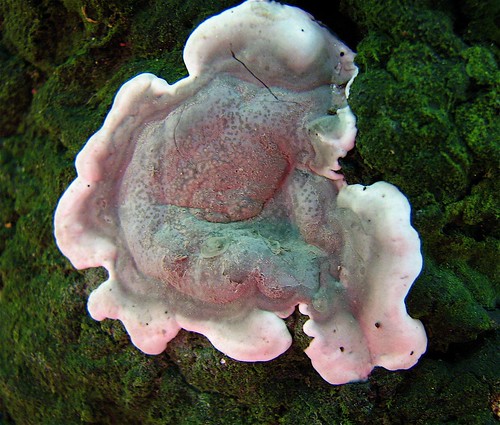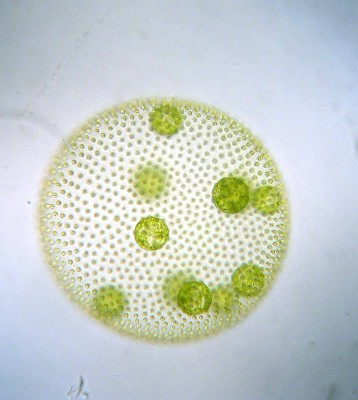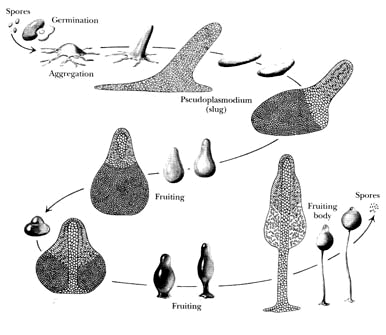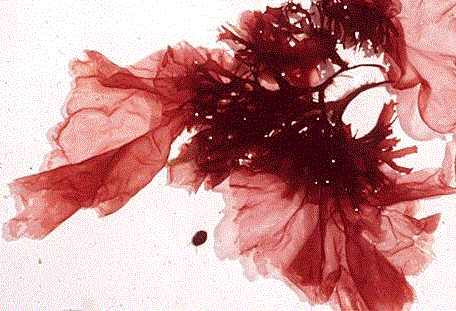‘Ello! My name is Kirstie, and I am here to tell you a bit about protists, and what I think about them, and the ways I learn.
I am extremely picky about organization all of my thoughts and opinions. Therefore, they are separate from my information and can be found and the bottom in my footnotes. :)
I am extremely picky about organization all of my thoughts and opinions. Therefore, they are separate from my information and can be found and the bottom in my footnotes. :)
"Kingdom at the crossroads."
 Protists are commonly classified as:
Protists are commonly classified as:• Free-living
• Eukaryotic
• Unicellular (but can be multi-cellular as well as form colonies!)
Although, they are most easily classified by what they are not:
animals, plants and fungi.
The most general variations in protists are:
• Chemicals that compose the cell wall
• Ways that they move (let’s do the locomotion!)
• Their means of getting energy![1]
• How they eat other organisms, if any.
• Whether they’re: unicellular, multicellular, aggregate, or colony.
* Another variation is pigment which determines the wavelength that is used to process food! [2]
The cell wall of a protest can be composed of:
• Cellulose (like dinoflagellates!)
• Algin (brown algae)
• Algar (red algae) [3]
•Calcium carbonate (forminifera)
• Silica (diatoms) [4]
Means of locomotion are:
• Flagella (a long, lashlike [addition] serving as an organ of locomotion in protozoa, sperm cells)
• Pseudopods (“false feet”) (a temporary [extension] of the protoplasm…usually serving as an organ of locomotion)
• Cilia (minuscule hairlike organelles, identical in structure to flagella, that line the surfaces of certain cells and beat in rhythmic waves)
Means of getting energy are:
• Photoautotrophs (Photosynthetic such as euglena and algae)
• Heterotrophs (They eat other organisms.)
• Mixotrophs (These kinds of protists eat other organism AND obtain energy from photosynthesis. Wow!)
How protists eat other organisms:
• Using cilia to push other organisms into a gullet (throat). (An example is a paramecium!)
• Using pseudopods to engulf other organisms! [5]
• Entering other cells to eat their nutrients from the inside. (Like plasmodium!)
Now, let’s get to some examples!
PLANT-LIKE
• Single-celled
• Photosynthetic
• Some flagellated/luminescent
• Live freely and in colonies
• Photoplankton (primary producers of oxygen)[6]
There are 3 types!
• Single-celled
• Photosynthetic
• Some flagellated/luminescent
• Live freely and in colonies
• Photoplankton (primary producers of oxygen)[6]
There are 3 types!
 Euglenophyta
Euglenophytaex. Euglena
- autotrophic and heterotrophic
- one flagellum with chloroplasts
[7]

Pyrrophyta
ex. Dinoflaggelates
- luminescent, produce toxins that shellfish absorb!
(called red tide)
[8]
ex. Dinoflaggelates
- luminescent, produce toxins that shellfish absorb!
(called red tide)
[8]
 Chrysophyta
Chrysophytaex. Diatoms
- Have silica cell wall
* Important component of marine plankton - food source!
Are also used in: detergents, polishes, paint removers
[9]
ANIMAL-LIKE (PROTOZOANS)
• Unicellular & colonial
• Eukaryotic
• Heterotrophic
• Eukaryotic
• Heterotrophic
There are 4 different kinds!

Ciliates
ex. Paramecium
- have a gullet, anal pore, and vacuoles
(reproduce by binary fission and conjugation)
[10]

Flagellates
ex. Trypanosoma
(reproduce sexually and by binary fission)
[11]
ex. Trypanosoma
(reproduce sexually and by binary fission)
[11]
 Sporozoans
Sporozoansex. Plasmodium
- causes malaria
- hides in liver and blood cells
(reproduce by spores)

Sarcodina
ex. Amoeba
(multiply by cell division)
* Each species of amoeba has their own set of shapes, and are able to change constantly!
* Many of these cause disease!
Plasmodial lime molds are actually protists and they prefer to live in close contact with one another. They come in orange and yellow and look like a "gross jell-o mass." They are also aggregates.
FUNGAL-LIKE
• Contain parasitic and predatory molds that produce spores
• Most are single-celled decomposers in aquatic habitats
There are 3 types of molds!

Phagocytic
- Live as single-celled amoeboid cells that migrate together and form spore-producing cells!• Contain parasitic and predatory molds that produce spores
• Most are single-celled decomposers in aquatic habitats
There are 3 types of molds!

Phagocytic
[12]

Acellular
- Help scientists study movement of protoplasm
- Form plasmodia at one point in life cycle

Cellular
- Help scientists study how cells communicate
- Function like a multi-celled organism at one point in life cycle
[13]
There are 3 types of algae!
Red Algae:
Contains phycobilin pigment that masks the chlorophyll.
- Has cell walls made of agar.
- Important source of food in Asia.
[15]

Brown Algae (also called fucus):
- Contains focoxantan pigment.
- It's cell walls are made of algin.
- Contains focoxantan pigment.
- It's cell walls are made of algin.
B i b l i o g r a p h y & O p i n o n s :
http://www.slideshare.net/mrskennedy/protist-notes
Super-neato slideshow! Lots and lots of information. It wasn't very showy, and some of it was hard to read, but I learned A LOT. So much info. For some reason I thought that 'dinoflaggelates' related to dinosaurs. WITH REASON! I found out, however, that they are actually plant-like protists! :)
* All of my images I obtained from google images with searches such as: "protist" "euglenophyta" etc.
I loveeee Google images! It's SO great! So many options to choose from and the uploading process is easy too.
http://www.microscopy-uk.org.uk/mag/indexmag.html?http://www.microscopy-uk.org.uk/mag/wimsmall/smal1.html
I really didn't like this website that much. I don't know if I was supposed to get a lot out of it or what, but I really didn't. I got my "fun fact" about amoebas (the bullet with the asterisk.) but aside from that nothing of great value stood out for me on this website.
http://www.microscopy-uk.org.uk/index.html?http://www.microscopy-uk.org.uk/ponddip/index.html
I wasn't able to use this website as each time that I clicked on one of the organisms my firefox
crashed. I tried many times, but no success. :(
http://ebiomedia.com/prod/ProtistsVideoDVD.html
This website was honestly difficult to get through. It was just really boring and intense. I didn't like it. :(
Your Notes
I really liked your notes! They’re really detailed, and interesting, and the examples you provide really help. These notes were dominant in the construction of this project
http://www.ucmp.berkeley.edu/alllife/eukaryotasy.html
This website was very fun and informative. Good pictures and lots of links!
F o o t n o t e s & T h o u g h t s :
[1] (Have you ever watched that video where there are the 3 men riding a bike (…3 person bicycle?!) and they’re singing “Energy is the force of life. It’s what makes the world go rouuuund!” I watched it in grade 8 science. Quite an inspirational film if I do say so myself.)
[2] I never knew that before! I didn’t know that pigment had anything to do with anything, and I find that super interesting that it has to do with food digestion!
[3] I find it SO interesting that these are in red jell-o. I was, and am, super impressed.
[4] I think it’s really neat how Silica is like mirror images. However much I’d like to display a diagram I cannot. I apologize profusely. :(
[5] Like Mrs. Cannon “hugged” Ally. Good example! I’ll remember it fo’ sho. :)
[6] I never knew that photoplankton produced most of our oxygen. That's so neat! :)
[7] I LOVE the way Euglena look. I find them so awesome. This picture reminds me of those jelly things that you can squeeze. I don’t remember what they’re called, though. :P
[8] Pyrrophyta remind me of those virus things. Helio-something? No? Either way, those and forks.
[9] I find it really neat how chrysophyta can be used in polishes AND detergents. Who knew?
[10] I adore the bold colours in this picture. It makes me really appreciate cilia.
[11] This picture of flagellates is so beautiful. It reminds me of ballet shoes/ribbons.
[12] This phagocytic fungal-like protist reminds me of snot. Quite gross.
[13] Mushroom?
[14] This photo of green algae reminds me of pea pods.
[15] I think the appearance of red algae is fantastic. It’s like when you put food colouring in water! Also – I think it’s really neat that it can cover up the appearance of the chlorophyll with red pigment!
--- I'm also going to tell you that I put far, let me emphasize FAR FAR FAR too much time into the "looks of this blog" and it's really put me into an unpleasant state. It's not working with me and spending another 2 hours on it is not how I'm going to spend the rest of my evening. I just thought you'd like to know.




Your "green" algae is a brown one! (Macrocystis sp)
ReplyDeleteThis is so interesting and it's kinda fun to be learning about all kinds of different things.
ReplyDelete